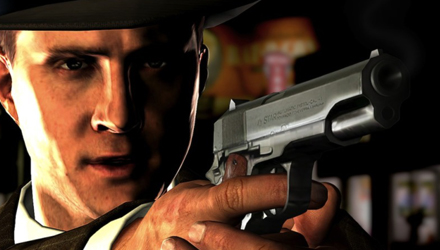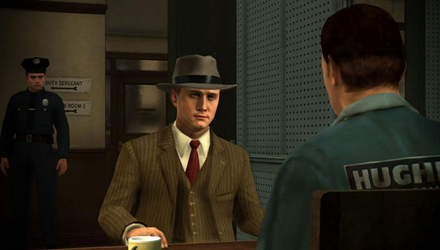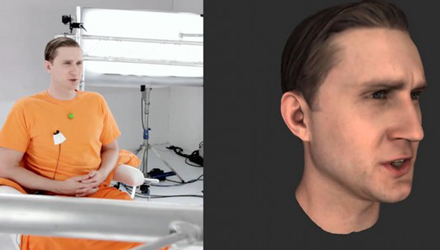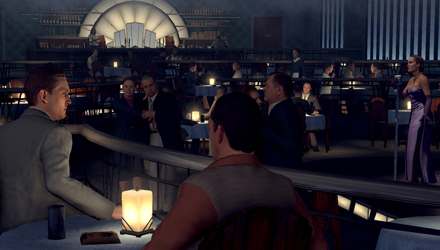Reviews
Review: L.A. Noire
July 5, 2011, Author: Trent Pyro
It would be fair to say I was an unusual kid. While most of my school chums would spend their free time playing football, watching football and generally delving into the all-consuming universe of football, I was playing cops and robbers. I was obsessed with crime fiction; I wrote it, read it and watched it on TV as much as I could. There was something about the way a crime was committed, investigated and solved that captured my imagination and it is an interest that’s stayed with me throughout my life. The one thing that was missing was a really good crime game. I bought every game that had a modicum of police work in it, only to find bland shooting and driving taking precedent over grass-roots investigation.
Enter a Team Bondi and Rockstar double act, and me at 22. My ear is usually pretty close to the ground and I heard rumblings of L.A. Noire soon after Red Dead Redemption hit the big time. First details were slight but immediately exciting. As more was revealed, the excitement only built. Would this be the game I’d been waiting for since I began playing? Could Team Bondi, a developer I’d never heard of, harness the gameplay we know and love from Rockstar and truly embrace new technology to deliver something stellar? Let’s find out, or should I say, investigate…
Sweet smell of success
Our story begins in 1947 Los Angeles. Reeling from the war and the changes it brought to the country, the police force are quickly losing control. Crime is on the rise and the expected boost in the force from ex-soldiers has not come. The city bleeds at night and no-one is doing anything about it. What L.A. needs is a hero. That hero is Cole Phelps.
Having survived the war as a First Lieutenant in the US Marine Corps, Cole still feels he can do more to serve his country. Signing up to the L.A.P.D., he quickly makes an impression on the beat and is promoted to Traffic Detective almost overnight. His face is on the front page of all the local papers, his name now household. Through the course of his story he’ll move up the desks, taking on Homicide, Vice and Arson. Something much more sinister is going on in the City of Angels. Something that will take Cole back to the war and show him how far soldiers can fall when war is done. Something that will prove that even the best of us can fall.
The plot in L.A. Noire is the most complex and deep I’ve seen in a long time. Each case is a self-contained adventure, with its own crime, witnesses, suspects and clues. After learning the basic skills of investigation while treading the pavement as a beat cop, you could theoretically approach any case individually and be fine. That would, of course, ruin the second layer of story; the desk plot. Each desk presents a string of crimes, seemingly unrelated but cleverly connected in a way only excellent crime fiction series have so far managed. Rather than ending with a whimper and a pat on the back, each desk comes to a crushing conclusion, elements large and small from all the aggregate cases coming together to finally present the big picture. It’s fantastic storytelling and is impossible to put down.
In addition to this, a third layer exists. By finding newspapers in the world Cole begins to see the threads of a huge web of people, drugs, death and crime. A doctor, an illegal market in military surplus morphine, soldiers with undiagnosed P.T.S.D. Soon enough the mob becomes involved, and the more you read these papers and watch the little cut-scenes each edition brings, the more you begin to connect the dots and realise that everything is connected. I won’t go any further here for fear of spoiling it.
My main point here is that if you pick one game of the last decade where you should never skip any cut-scenes or conversations, it’s L.A. Noire. Never has story been so important and vital to the gameplay. I’m confident in saying that missing one witness statement or even a single sentence could lose you a case entirely. The confidence to make dialogue that necessary should be applauded and seen as an example to other developers; there are those of us who want the dialogue and story to be like veins in the body, not just a reason for violence.

Don't mess with Mr. Spudface
Cole Phelps himself is an odd character. Very much an All-American boy scout, he is 100 percent dedicated to the job. While this allows you to immediately get stuck in with no reluctance from him, it can sometimes make him seem like a bit of a wanker. Partners will make jokes, sometimes just to make conversation, and Phelps will respond with what essentially sounds like an L.A.P.D. Handbook clause. Warming to his character takes time, but thankfully doesn’t impact on the enjoyment of the game one bit. That is until he acts entirely out of character and within the space of about 5 minutes your entire perception of who he is flips on its head. Revealing the event will spoil it’s intended effect, but I’ll just say it feels totally random and unnecessary. I suppose it shows that no-one is perfect and we all have our downfalls, but it’s a pretty heavy-handed attempt at hammering a vital film noir device into a plot which, up until that point, has been subtle and professional in its approach. Trust me when I say you’ll know it when you play it.
Other characters have varying degrees of importance, but are all very well written and acted. Each new desk brings a new partner, from the Homicide drunk Rusty to the suave, slightly shady Vice detective Roy Earle. Constants are common; the coroner, the crime scene photographer and many of the beat cops make repeated appearances, fully reinforcing the feeling of working in a real police force. The constant moving between desks and stations means it can be difficult to feel anything for characters not directly involved in the cases, but the change allows the plot to move at a good pace and stops it every becoming stale.
The influence of classic 1940’s noir cinema on L.A. Noire is obvious. Far from being derivative, however, the delicate and professional working-in of the game’s namesake style is hugely beneficial and lends not only a mature quality to the story lines, but also feels immediately cool and familiar. The world of post-war Los Angeles is immaculately recreated, with jazz clubs, gangsters and classic cars lining the streets. More importantly, it’s the little things that make this representation of America at that time more realistic, comfortable and overall believable than other recent attempts. Stalls on the street offering sandwiches and coke for cents and not dollars. Ladies laughing as they try on the latest fashions in the shops. Civil workers quietly smoking as they trek home from work, breaking silence only to shout abuse at your badge. The feeling of post-war America is present and correct and it adds a huge amount to the authenticity of the world.
The cases, too, owe a lot to film noir, each one a stylish and unique investigation. L.A. Noire itself could very well be a crime noir epic and would feel completely authentic. My feeling is that Team Bondi have tried to emulate and recreate that individual style and mood that film noir creates and make it interactive, and in that respect they’ve done a stellar job. While the parameters that truly define film noir are still being debated, L.A. Noire definitely fits the mould.
Cry of the city
Gameplay is a collision of old and new styles and for the most part works very well. The obligatory driving and shooting peppers an entirely new approach to 3rd person action, focussing on grass-roots investigation and heated interrogation to reach a goal.
Most cases begin with a crime scene. Sweeping it brings up clues you can investigate, highlighted by a pad rumble and a subtle chime. The system is brilliant, and one I’ve been awaiting for years. You have to guide Cole’s hand over the items and hit A to choose which one to look closer at. Using the analogue stick, you can move the item around to find hidden clues and important information. This can be something as obvious as an address, or as subtle as the residue from some sticky tape. While the variety of evidence and clues is admirable, there’s as much crap as there is useful stuff. More often than not you’ll hit a clue and get excited, only to realise it’s just a bottle or an ashtray. Zooming in to the objects takes time and it can sometimes feel like trial and error finding the important stuff. This hiccup doesn’t slow the game down too much, however, and enhances the feeling of doing real police work. The free-roaming exploration favoured in the GTA will do no good here, as L.A. Noire is strictly a story-based game. It’s better to think of it as a linear experience with multiple possible endings and a big city setting.
Most scenes also have a witness or person of importance to grill. The interrogation system is a revelation, and one that relies heavily on the much-touted, groundbreaking MotionScan tech. Each character is startlingly lifelike, with every nuance of their facial expressions faithfully bleeding through the screen. This allows you to use your own intuition and skills to figure out if someones telling the truth, not telling you everything or straight-up lying. The first two options are usually a matter of making a guess, watching the subjects eyes and listening for wavers in their voice. The third option, however, hinges on having the right evidence. If you have evidence to disprove a statement, hitting ‘Lie’ and choosing the right clue will burst the subject wide open and make you honestly feel like a proper detective. It works for interview room-based interrogations too, lending an amazing sense of realism and authenticity to what would usually be a boring section.

You'll be doing more of this than shooting and driving...
All of your clues and evidence is kept note of in your little notebook, which also give you access to other things. You can look at people of interest, including suspects and witnesses and review the info you have on them. You can look at important locations and set one as your destination, putting a little flag on your map. This map marks a return to the old school for Rockstar. While it appears as a standard mini-map/big menu map combo, there’s no GPS routes here. All you’ve got is yellow dots for important places and each police station marked by a white badge. You have to work out how to get around yourself, which is both a blessing and a curse. I learned to map read by planning routes on GTA and it’s nice to see that skill needed once again, but I fear the absence of the now-obligatory route line will put backs up across the world. The notebook also houses one of the most unnecessary things I’ve seen in a game for a long while.
Intuition is what Team Bondi have called a system that essentially helps you out when you need it. Earned by ranking up, Intuition Points can be used to eliminate a wrong path from an interrogation. This will highlight all the clues in an area or give you the option to ‘Ask the Community’ which path they took, in a sort of ‘Ask the Audience’ way. It all seems out of character to me, and immediately breaks the meticulously crafted illusion. The only option that has any use is the first one anyway. Highlighting the clues removes all the buildings from the mini-map and gives you a sea of magnifying glasses, causing you to run around structures like a drunkard trying to figure out where they are. Asking the Community is asking for trouble, because if most of the community chose wrong and therefore so will you, further adding to pool of misinformation. I can see the thinking behind it, but the Intuition system feels like such a lazy bolt-on I wish they’d just left out.
When the going gets tough, Cole has a few tricks up his sleeve to make getting physical that bit easier. Shooting is handled in recent Rockstar fashion; cover, aim, shoot, sprint, albeit with a few twists. This is not GTA, and as such Cole can only use his gun when the game says so. While this will surely have bedroom anarchists up in arms because they can’t gun down their fellow bobbys and generally cause mayhem, it’s a necessary restriction to preserve the mood of the game. How would it seem if boy-scout Phelps suddenly went bananas and gunned down three old ladies and a bus driver? Similarly the melee combat, while satisfying, is restricted to set sequences. The lifelike faces make landing a right hook all the more satisfying, although Cole seems to be able to punch with the force of Iron Man, a couple of whacks knocking any goon out cold. Chases are also made easier by a very smooth traversal system. Essentially holding RT and running forwards will get you up and over any obstacle (within reason) and make climbing ladders and fire escapes a breeze. It also handles jumps and does all this very well. It allows you to concentrate on catching the fleeing suspect and reduces the usual trial and error associated with chase sequences.
Not all bad guys run though. Some of them use motors. Thankfully Cole is pretty handy behind the wheel and most of the cars handle well, aside from Roy Earl’s convertible, which for some reason drives like a bus full of concrete. Screeching around the strangely clear streets of L.A., tearing after a desperate criminal, period siren wailing, is an experience few games can match. There’s something about knowing you’re the good guy that makes chasing the bad guy so much sweeter. Regular driving around is a bit boring, but no more so that taking a trip across Liberty City in one of the slower cars.
At the end of a case, when everything is coming together, these elements gel perfectly to give a fantastic experience. The more traditional action elements fit seamlessly with the new investigation system and every action makes sense. Sometimes it feels like Team Bondi made a guy run just because they were scared you might be getting bored, but most of the time it’s for a reason and feels natural. Overall L.A. Noire plays very well, but there are a few glitches. More than once my partner got stuck in a bush, forcing me to forge on without him until he magically reappeared in a conversation. That’s another thing; L.A. Noire has a habit of forgetting it’s a game.
Often you’ll drive to a place, only to be cut out before you get there and shown the car pulling up, Cole and the others getting out and approaching the door. Then the game lets you knock on the door, before wrestling back control when the occupant opens up. When these cinematic moments are tightly bunched, it’s easy to feel like you’re just pushing buttons on a DVD game. Thankfully it doesn’t sour the experience too much, largely down the the quality of the acting and the tech that allows us to see it so clearly.
Body and soul
MotionScan is the next step in video game character animation. No, really, it is. Created by Aussie company DepthAnalysis, it uses 32 HD cameras in a birdcage formation to capture every element of an actors performance simultaneously with their voice. The result is an amazing level of detail never before seen in a game. The only thing that’s come close, to my knowledge, is Enslaved, and the cartoony style of that separates it somewhat.

Behold... the future!
Every actor is captured, whether they’re just a desk clerk or Cole Phelps himself. This level of performance is what has allowed Team Bondi to craft a game that’s about people, about how they speak and move and twitch and lie. More than Kinect or any motion control, it allows you to use your mind and your skills at reading people to succeed. It’s a masterstroke and will hopefully make it into our favourite franchises soon. Imagine the next Elder Scrolls game with fully MotionScanned characters. What about capturing famous players and manager’s faces for the next FIFA or Pro Evo? The possibilities are endless, and while L.A. Noire doesn’t lean on the tech too much, it does use it very effectively.
As for the world, L.A. has been lovingly recreated in all its post-war glory. The Hollywoodland sign looms over the city, streets lit by neon signs in some places and barrel fires in others. Massive as the map is, you never feel like you’re just driving down the same street over and over again. Each location has a personality, and little details make the difference; flyers on the wall of the jazz club, photos and personal effects littering a suspects apartment. Litter on the pavement, a woman tripping over a loose slab, two people arguing about a mis-timed road crossing. It feels as alive and as real as Liberty City, with the added magic of that noir sheen. Flick on the sweet monochrome filter, find an iconic spot and wait for it to rain. Then smile as the feeling of really playing a noir movie washes over you.
The sound of fury
As mentioned before, the quality of acting in L.A. Noire is excellent. It has to be for the MotionScan to be useful in-game. The key characters are performed brilliantly, adding an authentic feel to the traditional noir stereotypes but each being a unique and deep character in their own right. Every suspect, witness and interviewee is also performed to a high standard. That said, sometimes feels like an actor is exaggerating a lie to make it easier for the player, this is a rare occurrence and more often than not it’s difficult to reach a definite conclusion by simply looking at the facial expression.
Most other sounds are nicely mixed and well designed, but it’s the ensemble that really brings the game to life. People talking on the street, cars motoring past, busses squeaking as they pull in to stop, shopkeepers shouting at customers and sirens screaming across the city. The sound of your feet striking the pavement and echoing off the cold brick walls as you investigate a dark alley searching for clues. The rain lashing against the car windows as you cruise around the empty evening streets, hoping for a dispatch call to break the tedium of a quiet night. It all combines to create an atmosphere that fits perfectly with the noir stylings.

If jazz is your thing, then the Blue Room is where it's at...
The music is also of note. A heady mix of traditional noir orchestral beats and period jazz, it sets the mood for every situation. Chase sequences are driven by panicked orchestral stabs, while harrowing moments of confession are lashed with sombre strings and haunting trumpets. Dark alleys drip with horns and deep cellos and the police stations bustle with quick brass. Jazz seeps from clubs and radios across the city, winging its way into the game when the mood is needed. While I assume it’s all period correct, don’t expect to hear any familiar tunes unless you’re a jazz fan.
Music is used to effect in other areas too. Special music plays when you enter a clue-rich area, with the aforementioned chimes indicating nearby evidence. The music fades when all the clues are found. It’s a brilliant way of eliminating old, visual devices and aids the immersion no end.
Odd Man Out
L.A. Noire is a prime example of what happens when a brand new developer is given the opportunity to work with a mega-studio, to go on to make a masterpiece. The new studio’s fresh, original ideas and youthful confidence has been bolstered by the old dogs experience, manpower and cash-flow to produce a rare gem; a game apart from all others. There is genuinely nothing like L.A. Noire out there, and there never has been. Take the investigation and deduction of a point-n-click adventure, throw in some GTA driving and shooting and sprinkle with a revolutionary new piece of tech and you’re some way to explaining how successfully this game has combined age-old conventions to produce something new. Far from derivative, however, it carves its own niche and Team Bondi have been confident enough to pump in their own original ideas when appropriate.
Sure the action sequences can seem dull at times but film noir was never about the action. The graphics don’t make your eyeballs cry with joy but film noir was never about good looks. The cases can sometimes seem overcomplicated, but that’s what film noir is all about; getting to the bottom of it and finding the truth. Lost hope, deals gone bad, a city turning on its people and making them do terrible things. A lone cop, trying to make a difference, brought down by the very town he’s trying to save. L.A. Noire has something most games lack; poetry.
It is that poetry that makes it one of the must have games of this year. Forget about coffee shops and useless pubs, clear your mind of fast cars and skyward civilians. Turn the lights out, get yourself a cup of joe and settle down with one of the most original and enthralling games of this generation.
Platforms: PS3, Xbox 360 | Tagged 40's, car chases, cops, Detective, driving, film, Investigation, LA, los angeles, mob, murder, noir, noire, period, post-war, robbers, Rockstar, shooting, Team Bondi



